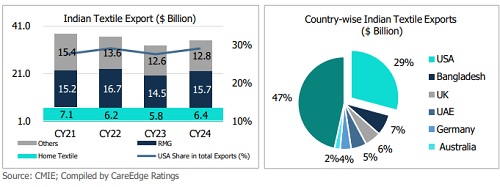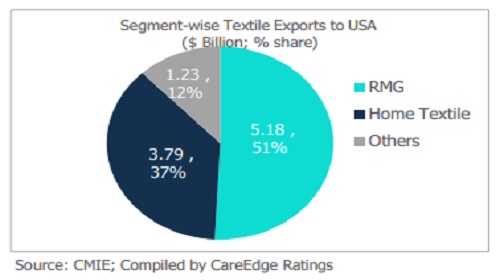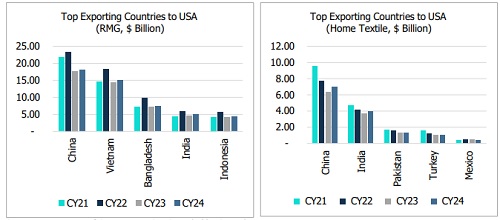USA Tariff Hike to 50% Threatens India`s $35 billion Textile Export Competitiveness by CareEdge Ratings

Synopsis
* Indian textile and apparel industry size stands at ~USD 160-170 billion, of which the domestic industry accounts for ~78-80%. India’s textile and apparel exports were ~USD 35 billion in CY24, with ready-made garments (RMG) and home textiles accounting for the majority share of around 63%. The USA remains the largest export destination for Indian textile and apparel products, accounting for ~28-29% of total exports, which stood at around $ 10.5 billion in CY24.
* Following tariff hikes by the USA from 25% to 50% on Indian goods, Indian textile exporters face a significant cost disadvantage in the USA market compared to its peers. This may shift some orders to competing countries with relatively lower tariffs.
* While Indian textile and apparel exports in CY25 are expected to decline marginally, a significant decline in exports to the USA is expected in CY26 following a sharp rise in tariff rates, potentially reducing overall textile exports by 9-10% to ~USD 30 billion. With anticipated loss of revenue and partial tariff absorption, if any, PBILDT margin of Indian RMG and home-textile exporters is expected to decline by 300-500 bps. However, the extent of decline depends on the ability to negotiate product pricing with customers in the USA to retain volume.
* Mitigating factors include India’s strong presence in the cotton-based textile value chain, especially in the home textile segment, being the second largest supplier to the USA, currency depreciation and expected increase in exports to the EU, UK, and the Middle East under Free Trade Agreements (FTAs). Additionally, the export loss of RMG and home-textile products is likely to be compensated by growth in exports of cotton yarn and fabric as the competing nations lack backwards integration in these products.
The USA is a key Market for Indian Textile Exports
Following the Executive Order issued by U.S. President Donald Trump, a secondary tariff of 25% on Indian goods has come into effect from August 27, 2025 due to India’s purchase of Russian oil taking aggregate tariff to 50%. The textile industry is expected to be significantly affected by the additional tariff. Since the 50% tariff is on top of the previous Most Favoured Nation (MFN) duty, the effective tariff on Indian textile products now ranges between ~52%-64%.

The USA has been the largest export market for Indian textile and apparel, accounting for 28-29% of exports over the last four years ended CY24. India primarily exports cotton-based textile products to the USA, predominantly home textiles and apparel, which together accounted for ~90% of Indian textile exports to the USA in CY24. Besides the USA, the other key export markets for India’s textile sector are Bangladesh (7%), the UK (6%), the UAE (5%), and Germany (4%), among others.

Major exporting countries to the USA

In the USA textile market, India competes with countries like China, Vietnam, Bangladesh, Pakistan, Turkey, Mexico, etc. In the short term, higher tariffs on textile imports from India would increase the cost of Indian textiles in the USA market, reducing their price competitiveness against other exporting countries. This increase in cost is likely to dampen demand for Indian textiles, potentially affecting export volumes.
Competing countries, such as Vietnam, Bangladesh, Pakistan and Indonesia, face secondary tariffs of 19-20%, whereas China’s secondary tariffs are capped at 30% at present. Consequently, orders for RMG are likely to shift toward these countries unless Indian exporters absorb through steep discounts. China has a tariff disadvantage compared to other exporting nations, but a lower secondary tariff than India. Some orders in home textiles may also shift to China if buyers can’t get Indian prices down. The effective tariff rates (Base duty + Secondary tariff) by US for import of textile products from China stands at ~46-52% compared to ~52-64% for India.

Impact on Indian Textile Export
Until August 2025, Indian textile exports have largely remained unaffected, as tariffs were broadly in line with those of key competing nations. In H1CY25, India’s aggregate exports to the USA increased by ~7% over H1CY24, reaching USD 5.45 billion. Despite a likely shift in orders towards competing nations, Indian textile exports are not expected to materially decline in CY25, as some US buyers have also advanced their shipments from India ahead of the expected August 27 tariff hike.
However, in CY26, Indian textile and RMG exports to the USA could decline significantly due to unfavourable tariff rates compared to competing nations and the expected decline in consumer demand driven by rising prices in the US market. This would be despite India’s strong foothold in the cotton-based textile value chain and its dominant position in the home textile segment, limited capacity of competitors to meet quality and specific customer requirements for certain orders, and the benefit from the potential depreciation of the Indian Rupee. Trade agreements with other countries, such as the FTAs with the UK, and ongoing negotiations with the EU, could help offset some of the losses in US exports.
CareEdge Ratings expects India’s overall textile export to decline by 9-10% in CY26 to USD 30 billion, considering the significant decline in exports to the USA. The volume loss to the USA is expected to be partially offset by the expected increase in exports to the EU, UK, and the Middle East. With anticipated loss of revenue and partial tariff absorption, PBILDT margin of Indian RMG and home-textile exporters is expected to decline by 300-500 bps. Growing demand from the domestic market may support profitability of the sector to a certain extent.
CareEdge Ratings’ View
India’s textile and apparel exports, valued at USD 35 billion in CY24, have a significant dependency on the USA, as it accounts for ~28-29% of India’s overall exports in this sector. The US Government’s decision to raise tariffs on Indian goods to 50% from August 27, 2025, will affect the competitiveness of Indian textile exporters. This is expected to shift some orders towards competing nations, such as Vietnam, Bangladesh, Pakistan and China, among others.
Indian textile exports are not expected to decline materially in CY25, as some US buyers have also advanced their shipments from India ahead of the August 27 tariff hike. However, in CY26, Indian textile exports to the USA could decline significantly. The expected decline in exports is likely to be compensated by increase in exports to UK aided by India-UK FTA, and ongoing FTA negotiations with the EU. The India-UK FTA is a game changer for India’s RMG and home textile sectors, creating a level-playing field vis-à-vis key competing nations for accessing the nearly USD 23 billion UK import market.
“India’s textile export is expected to decline by 9-10% in CY26. With expected loss of revenue and partial tariff absorption, PBILDT margin of Indian RMG and home-textile exporters is expected to decline by 300-500 bps,” stated Akshay Morbiya, Assistant Director at CareEdge Ratings. However, the degree of decline will ultimately hinge on how effectively Indian exporters can negotiate pricing with their US customers to retain volumes.
“The Government of India has removed 10% import duty on cotton till December 31, 2025. Additionally, expected support from the Government in the form of expanding export markets through its dedicated outreach programme to 40 nations, as well as export incentives and interest subsidies, can support the competitiveness and profitability of Indian textile exporters. Moreover, the export loss of RMG and home-textile products is likely to be compensated by growth in exports of cotton yarn and fabric as the competing nations lack backwards integration in these products. Extent of benefit from India-UK FTA and potential trade agreement with EU remain key monitorable,” said Krunal Modi, Director at CareEdge Ratings.
Above views are of the author and not of the website kindly read disclaimer























